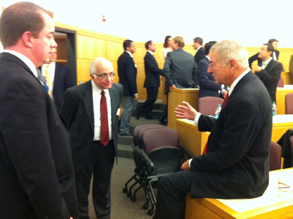
In the last year, SAS CEO Jim Goodnight and a group of R&D, Education, Sales and Marketing executives visited several universities that are in the early stages of adopting analytics within their business programs. To that effort, Goodnight addressed faculty and students at Indiana University's Kelley School of Business on Monday, Oct. 24.
School administrators invited Goodnight and several SAS customers to discuss leadership and to provide insights into how business analytics are being used across multiple industries. Executives from Procter & Gamble, Eli Lilly, Deloitte Consulting and the Institute of Defense and Business participated in a panel and later joined the SAS team at a private luncheon.
Kelley recently launched a Business Analytics Institute to augment its business program. The institute was inspired by heightened demand for analytics skills from employers who recruit at the business school. Frank Acito, a professor of marketing in the Business Analytics Institute, said that soft management skills are "the cost of entry" when students apply for jobs, but analytics skills will differentiate them from all the other business school graduates.
Goodnight shared that sentiment. "MBA majors don't need to know how to do all the analytics, but they need to understand their power and when to use them," he said.
Mark Zozulla said his company, Deloitte Consulting, predicted that business analytics will be a $5 billion business for them by 2015. "We want to see a lot more people graduating with majors and minors in BA. We can't get enough of them."
Goodnight described many of the aspects of business that are improved by analytics today. If you go into a store, the products you see may have been selected, priced and arranged on shelves with the influence of SAS®. If you use your credit card, it may be approved by SAS, likewise if you go into a bank to apply for a loan. Manufacturers analyze comments from warranties to find out what parts are failing and correct them in the shortest possible time. He mentioned multiple forms of fraud detected by SAS and how quickly SAS can identify risk from hundreds of thousands of variables. What’s more, almost every drug on the market was evaluated with SAS.
Students leaned forward in their seats, realizing the opportunities for them in every industry. During the Q&A session, one of the top concerns of students was how to get business executives, who are accustomed to making gut-based decisions, to begin factoring analytics into their decisions.
“How do you get a seasoned exec to listen to a 20-something-year-old analyst?” one participant asked.
Goodnight said business leaders who ignore the numbers today do so at their own peril. In the current economic and regulatory environment, executives answer to journalists, politically sensitive regulators and jittery stockholders. MBA grads who are exposed to analytics in their business school curriculum may serve as a bridge between analysts and executives.
The panelists agreed that inspiring confidence in the numbers was a challenge. They recommended using sophisticated visualization software to create simple, easy-to-understand reports and graphs. They told students it was their job to bring the mess to order. Additionally, they recommended communications skills training, imparting that they must be able to clearly articulate the problem, the methods they used to analyze the problem and credible recommendations.
"You also need to understand what a particular executive will be receptive to,” said Mel Halkyard of Eli Lilly. “You may need to present the facts differently to different leaders."
Another issue that surfaced repeatedly was how much data is enough? From the perspective of the business analysts, the answer was "all of it." Tom Lange, Director of Simulation and Modeling at Procter & Gamble, said that IT routinely throws away data every year because it's too expensive to store.
“The people who make decisions about data are still operating on a cost-cutting model,” he said, “a paradigm that's a decade old. But Walmart, I promise you, is keeping it!"
Deloitte's Zozulla questioned whether the cost of storing data could exceed the cost of ignorance. "If I'm a bank, I need a 360-degree view of my customers. It's not just about making money; it's also about making sure I don't lose money on my customer. For example, if I see that someone is drawing down their savings account, combined with a few other factors, I may be able to predict that they're about to default on their mortgage."
Continuing on the theme of data, students asked about innovations in various forms of unstructured data, including social media. Goodnight described how organizations can analyze vast amounts of online social content to monitor sentiment.
Students clearly equated data and analytics with opportunity and value. But one student’s question revealed an undercurrent of trepidation: "What should be taught? As we get more data, bigger data sets, I'm afraid of misinterpreting. Is it a problem that an MBA doesn't understand what happens behind the scenes?"
Goodnight smiled. "People always tell us they want SAS to be easy to use, but I don't want to make it too easy. I think there's a minimum of knowledge you need to avoid misinterpretations. You do need some statistical background." Fortunately more and more business schools agree.

1 Comment
Pingback: SAS CEO Jim Goodnight on education reform - SAS Voices